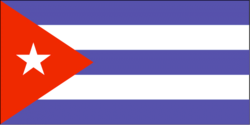Flag of Cuba
|
|
The flag of Cuba was adopted on May 20, 1902.
| Contents |
Birth of the flag
The Cuban flag's origins are in 1899, when various movements to liberate Cuba from Spanish rule emerged, mainly among Cuban exiles in the USA. Anti-Spanish Cuban exiles under the leadership of Narciso López adopted a flag suggested by the poet Miguel Teurbe Tolón. His design, which later became the current national flag, incorporates three blue stripes, representing the three military districts of Spanish-dominated Cuba, and two white stripes symbolizing the purity of the patriotic cause. The red triangle stands for strength and constancy, but it may also reflect Masonic influences (triangles are Masonic symbols for equality and were found in a number of other flags in the former Spanish empire). The white star in the triangle stands for independence. López carried this flag in battle at Cárdenas (1850) and Playitas (1851). Although the battles were unsuccessful, these were the first times the flag was raised in Cuba.
Subsequent use of the flag
After the United States seized Cuba from Spain during the Spanish-American War, the Stars and Stripes flew from January 1, 1899, until independence was granted. On May 20, 1902, the Cuban national flag was hoisted as a symbol of independence and sovereignty. It has been used ever since; it was not changed after the Cuban Revolution, when Fidel Castro seized control of the country. However, like Fulgencio Batista, Castro makes use of a party flag in all public activities. Castro's 26th of July Movement created a party flag equally divided in red and black, usually in horizontal stripes and often with inscriptions.
See also
- The flag of Cuba is similar to the flag of Puerto Rico; only the blue and red are reversed.
| National flags |
| List of national flags | List of national coats of arms |
External link
Template:FOTWde:Flagge Kubas fr:Drapeau de Cuba it:Bandiera cubana he:דגל קובה ja:キューバの国旗 pt:Bandeira de Cuba

